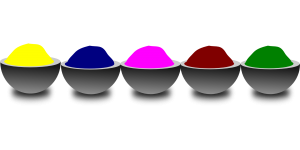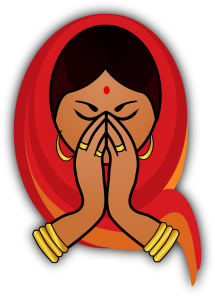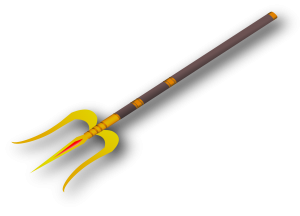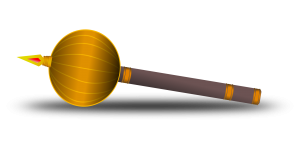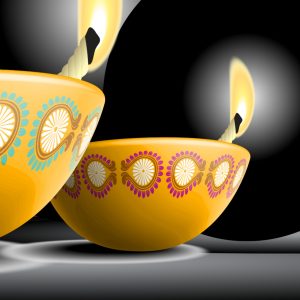
The following is an excerpt from Impressions of Bhakti: Śrī Śrīmad Bhaktivedānta Nārāyaṇa Gosvāmī Mahārāja recalls his early years
The Mahaviri Jhaṇḍa Festival (in honour of Hanumānjī) once took place on the banks of the Gaṅgā near my 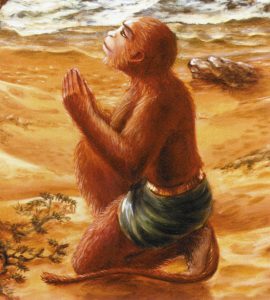 village, in Ahalyāvalī* – the area where Śrī Rāmacandrajī had liberated Ahalyā from Gautama Ṛṣi’s curse, where Viśvāmitra’s residence was situated, where Rāma and Lakṣmaṇa killed the demoness Tāḍakā, and where Rāma shot His arrows at Mārīca and Subahu in order to protect Viśvāmitra’s yajña. It was a great festival, at which many thousands of people gathered. Various games and wrestling matches were played, which were attended by numerous good sportsmen, and my father also participated as he had versatile talents.
village, in Ahalyāvalī* – the area where Śrī Rāmacandrajī had liberated Ahalyā from Gautama Ṛṣi’s curse, where Viśvāmitra’s residence was situated, where Rāma and Lakṣmaṇa killed the demoness Tāḍakā, and where Rāma shot His arrows at Mārīca and Subahu in order to protect Viśvāmitra’s yajña. It was a great festival, at which many thousands of people gathered. Various games and wrestling matches were played, which were attended by numerous good sportsmen, and my father also participated as he had versatile talents.
It was at this festival that I heard and saw, for the first time in my life, a nagara-saṅkīrtana with thousands of people dancing and singing, “hare rāma hare rāma, rāma rāma hare hare / hare kṛṣṇa hare kṛṣṇa, kṛṣṇa kṛṣṇa hare hare.” That nagara-saṅkīrtana had a great impact upon me.

The following is an excerpt from Śrīla Bhaktivedānta Nārāyaṇa Mahārāja’s commentary in the form of a chapter-endnote on Jaiva-dharma
Ahalyā – the wife of the great sage Gautama Ṛṣi. Indra, the chief of the devas, was infatuated with the beauty of 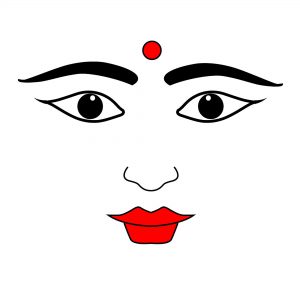 Ahalyā. Once in Satyayuga, while Gautama Ṛṣi was away, Indra assumed the form of Gautama by mystic power and had union with Ahalyā. When Gautama returned he could understand the whole situation through his yogic power. Furious with his wife, Gautama cursed her to become a stone. Ahalyā was deeply aggrieved and fell crying at Gautama’s feet to beg for deliverance from the curse. Gautama consoled her by saying that in Tretā-yuga, when Bhagavān Rāmacandra would appear on the earth, He would touch the stone with His foot and she would thus be delivered from the curse.
Ahalyā. Once in Satyayuga, while Gautama Ṛṣi was away, Indra assumed the form of Gautama by mystic power and had union with Ahalyā. When Gautama returned he could understand the whole situation through his yogic power. Furious with his wife, Gautama cursed her to become a stone. Ahalyā was deeply aggrieved and fell crying at Gautama’s feet to beg for deliverance from the curse. Gautama consoled her by saying that in Tretā-yuga, when Bhagavān Rāmacandra would appear on the earth, He would touch the stone with His foot and she would thus be delivered from the curse.
Normally Satya-yuga is followed by Dvāpāra and then Tretā in the cycle of the four yugas. Ahalyā appealed to Gautama, saying that she would not be able to bear waiting so long for the appearance of Rāmacandra. Gautama assured her that in this particular cycle of the four yugas, Tretā would follow Satya. By the desire of Gautama Ṛsi, the order of the yugas was reversed. When Rāmacandra appeared, He touched that stone with His foot and Ahalyā was released from the curse. Thus Ahalyā, who had assumed the form of a stone, was liberated from the state of covered consciousness (āchādita-cetana), at which time she was reunited with her husband.

The following is an excerpt from Śrī Rāmacandra-avatara by Śrīla Bhakti Vallabha Tīrtha Mahārāja
Ahalyā was freed of the curse of becoming a stone, by dint of her encounter with Śrī Rāmacandra. The great sage Gautama was the husband of Ahalyā. Devarāja Indra deceived Ahalyā by assuming the form of Gautama and corrupting her chastity. Displeased with this, Gautama cursed Ahalyā and Indra. Turned to stone by the curse of Gautama, Ahalyā remained without food for many years, surviving only on air. Ahalyā was finally freed from this curse by the touch of the lotus feet of Śrī Rāmacandra, and was then reunited with her husband, Gautama.

The following is an excerpt from Śrī Gīta-govinda by Śrīla Bhaktivedānta Nārāyaṇa Mahārāja
There is another explanation behind the moon’s deer-shaped blemish. When the moon was abetting Indra’s illicit meeting with Ahalyā, the wife of Gautama Ṛṣi, the sage angrily threw his deerskin āsana at the moon, which left a mark, and cursed him with kṣaya-roga, the painful disease of decreasing for 15 days every month.
meeting with Ahalyā, the wife of Gautama Ṛṣi, the sage angrily threw his deerskin āsana at the moon, which left a mark, and cursed him with kṣaya-roga, the painful disease of decreasing for 15 days every month.

The following is an excerpt from Bhakti-rasāyana by Śrīla Bhaktivedānta Nārāyaṇa Mahārāja
How much śakti can be in foot-dust? Once Śrī Rāmacandra was walking along in a forest and he came across Gautama Ṛṣi, who had cursed his wife, Ahalyā, to become stone. When Rāma touched that stone with his feet, she immediately assumed her original form as a very beautiful goddess. She circumambulated him, offered him prayers, and then bid him farewell and left with her husband.

The following is an excerpt from Pinnacle of Devotion, 2nd edition, by Śrīla Bhaktivedānta Nārāyaṇa Mahārāja
You may have heard the names of Arundhatī, Sāvitrī, and Damayantī, and there were so many other chaste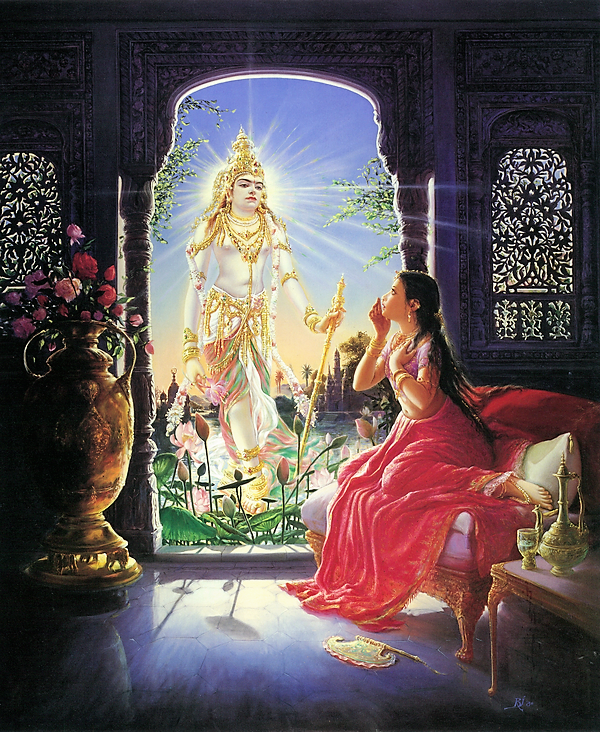 ladies like them in Indian culture. You may have also heard the names of Draupadī, the wife of the five Pāṇḍavas; Kuntī, the mother of the Pāṇḍavas; Mandodarī, the wife of Rāvaṇa; Ahalyā, the wife of Gautama Ṛṣi**, and Tārā, the wife of both Sugrīva and Vāli.
ladies like them in Indian culture. You may have also heard the names of Draupadī, the wife of the five Pāṇḍavas; Kuntī, the mother of the Pāṇḍavas; Mandodarī, the wife of Rāvaṇa; Ahalyā, the wife of Gautama Ṛṣi**, and Tārā, the wife of both Sugrīva and Vāli.
At first Tārā was married to Vāli, but when he was shot and killed, she became the wife of Sugrīva. Mandodarī was the wife of Rāvaṇa, but after he was killed by Lord Rāmacandra, she lived with Vibhīṣaṇa. Kuntī had five husbands, namely Sūrya (the sun-god), Pāṇḍu, Yamarāja (Dharmarāja), Vāyu (the air-god), and Indra (the king of heaven), but still she is considered superior to all other chaste ladies. Draupadī also had five husbands, but still she is celebrated as kanyā, a sacred unmarried girl. Although these five ladies were apparently married to someone else, and although some of them even had more than one husband, they always thought, “Kṛṣṇa is my beloved, my heart and soul.” Their marriages were therefore not obstacles to their bhakti. These ladies are glorified and honoured as kanyā, because they loved Kṛṣṇa or Rāma more than their husbands.

The following is an excerpt from Exclusive Guardianship by Śrīla Bhakti Rakṣaka Śrīdhara Mahārāja
Draupadī had five husbands, but if we take her name then we will be purified:
ahalyā-draupadī-kuntī-tārā-mandodarī yathā
pañcakanyā smaret nityaṁ mahāpātaka nāśanam
All these five ladies had more than one husband, but they were gained by circumstance. The scholars may make you feel cautious, but do not think in that way: if you take their name you will be purified—such is their position.
* The name of Śrīla Bhaktivedānta Nārāyaṇa Mahārāja in his previous āśrama was Śrīman Nārāyaṇa Tivārī. He took birth in a highly educated and respected brāhmaṇa family, in the famous village of Tivārīpura. Near the village Tivārīpura is Ahalyāvalī, the place of Ahalyā-devī.
** Ahalyā, though the wife of Gautama Ṛṣi, also had some connection with Indra. However, she loved only Lord Rāmacandra and was delivered by Him.
Image/Art made possible by Pixabay.com & Krishnapath.org

